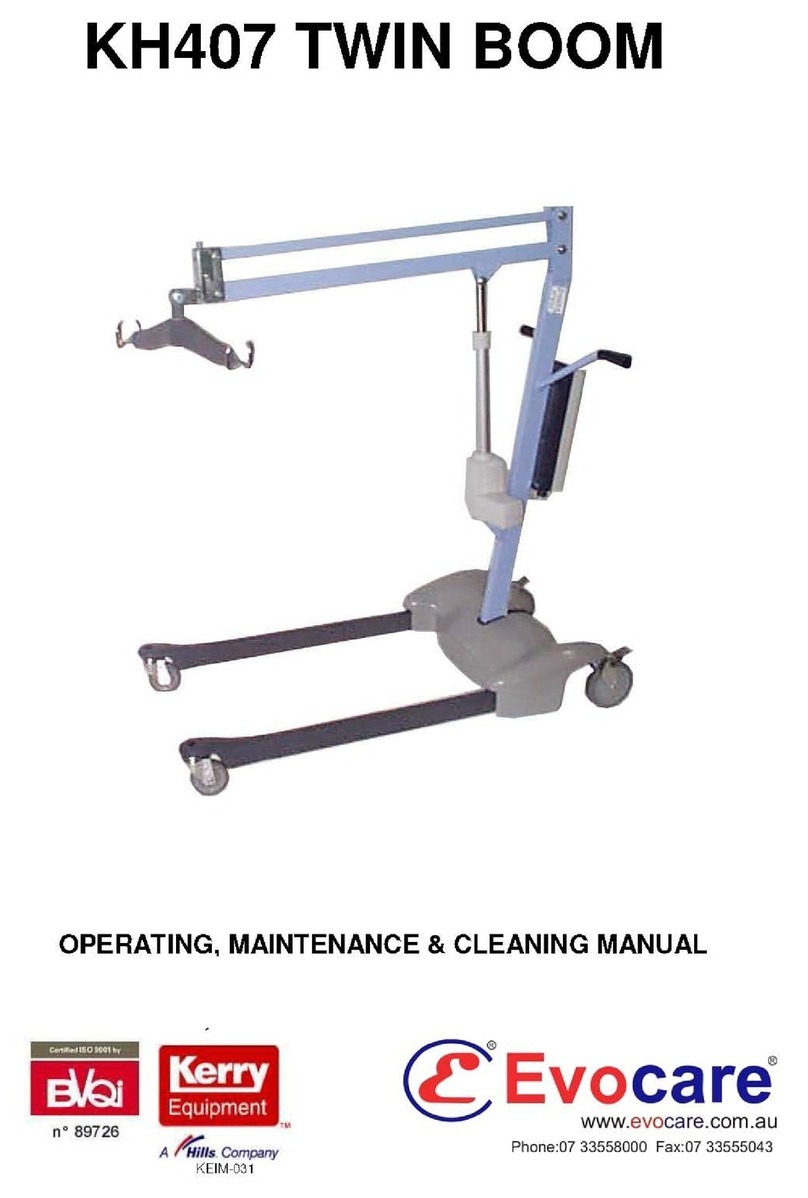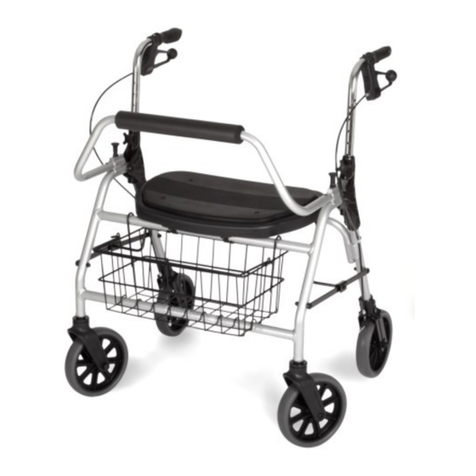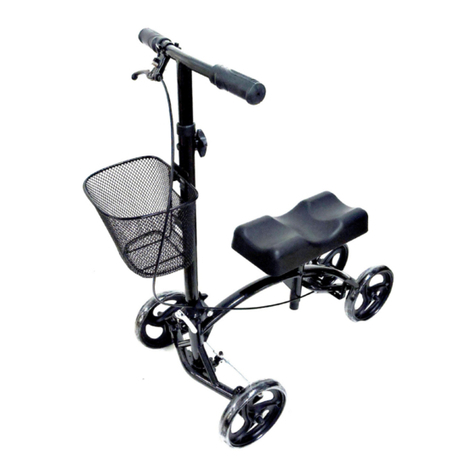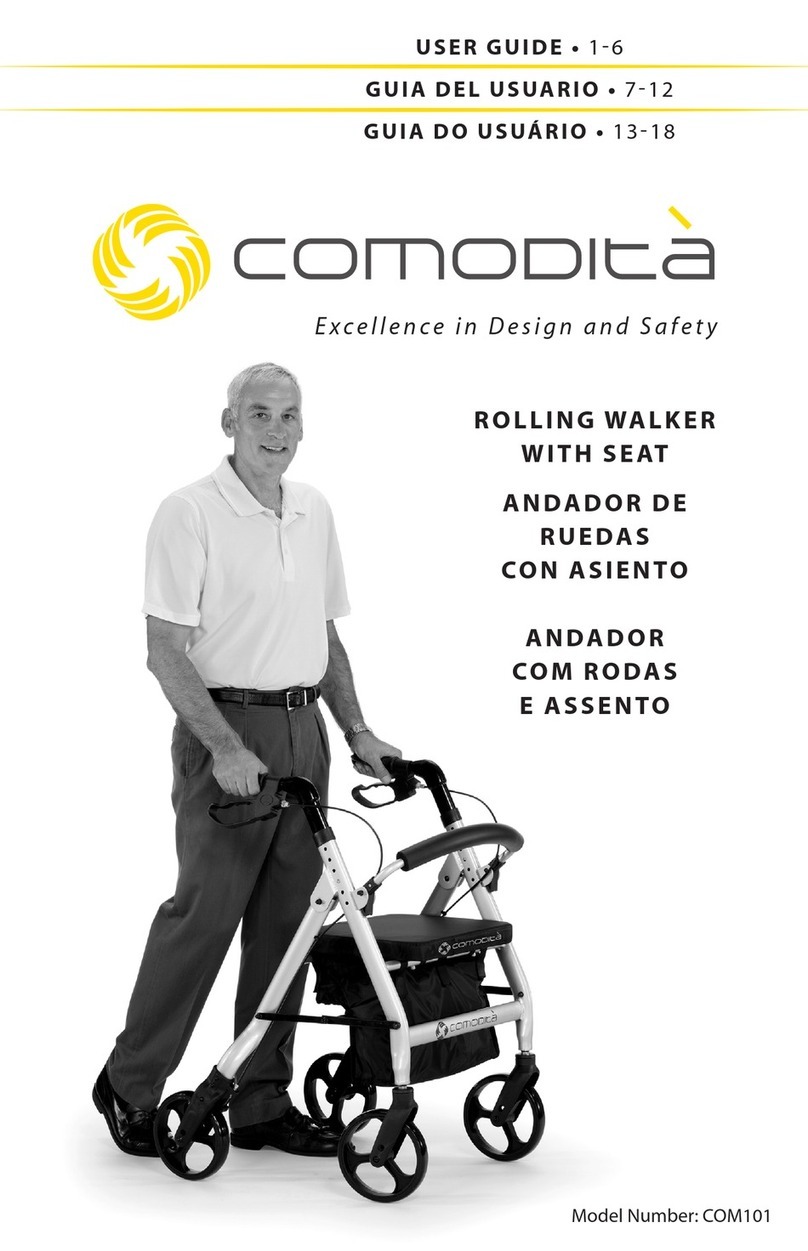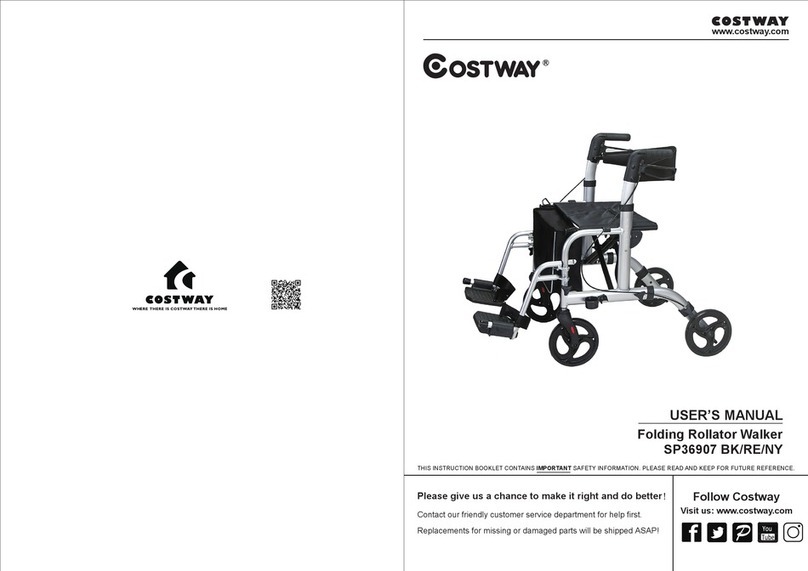Evocare Oxford Transaid 130 Operator's manual



Oxford®
Oxford Transaid 130
294000.10398 Rev A
3
1. Introduction
The Oxford Transaid 130 is a manually operated transfer device that facilitates patient transfer (short distances
only).
This user manual provides information on the following:
• Carton contents
• General guidance for use and an overview of the product
• Step by step operating instructions
• Maintenance and inspection information
• Warranty information
The Transaid 130 meets the European Standard IS) 10535 and the GQ-label T-02, cluster UTT
The Oxford Transaid 130 meets the requirements of the Medical Devices Directive 93/42/EEC of
14th June 1993, amended 2007/47/EEC of 21st March 2010.

Oxford®
Oxford Transaid 130
294000.10398 Rev A
4
2. Carton Contents
• 1 x Oxford Transaid 130
• 1 x Back support (white)
• 1 x Seat (black)
• 1 x User manual
Place the carton in a clear working area and open carefully.
WARNING
The Oxford Transaid is heavy and should be lifted carefully out of the carton by a minimum of two people.
When lifting the Transaid, ensure good manual handling practice is maintained. To avoid injury, DO NOT
attempt to lift the Transaid by holding onto the back support.
Remove the packaging supplied with the Oxford Transaid 130. Check the contents of the carton against the
list above.
3. General Guidance for Use
The Oxford Transaid is designed to assist with care duties for patients who have some difficulty walking but
have the ability to stand independently. Using this device assists the caregiver to be able to move the patient
safely and efficiently. The Oxford Transaid is not suitable for patients with low cognitive ability or little or no upper
body strength. The patient must be able to weight bear and also be of a cooperative disposition.
Should you have any doubts about using this product, please contact your local Oxford distributor or Joerns
Healthcare. Please note, the Oxford Transaid is composed mainly of stainless steel and is therefore suitable for
use in wet areas.
The Oxford Transaid can be used for the following types of transfer:
• From a chair/wheelchair to and from the toilet
• From a chair/wheelchair to and from a bed
• From a chair/wheelchair to and from the shower

Oxford®
Oxford Transaid 130
294000.10398 Rev A
5
WARNING
• The Oxford Transaid 130 is designed to facilitate the transfer procedure. Any other use is not permitted.
• The Oxford Transaid has a maximum safe working load of 130kg. DO NOT exceed the safe working load.
• ALWAYS maintain a clean and tidy working environment.
• ALWAYS plan the transfer operation before commencing.
• ALWAYS carry out transfer operations according to the instructions in this user manual.
• DO NOT push the Oxford Transaid at speeds exceeding a slow walking pace.
• The Oxford Transaid 130 should be used by competent, trained personnel only.
• The Oxford Transaid 130 should be maintained and serviced at least once a year, by a competent person.
• Should the Oxford Transaid be damaged during normal use or in transit, the product must not be used.
Please contact your local Oxford distributor or Joerns Healthcare.
• The patient should ALWAYS be seated during the transfer and the back support should be positioned
behind the patient.
• The Oxford Transaid should only be used on flat surfaces.
• Only approved genuine spares should be used when replacing parts.
• DO NOT use the back support to lift the product when transporting or storing the device.
• DO NOT park the Oxford Transaid on any sloping surface, loaded or unloaded.
• DO NOT manoeuvre the Oxford Transaid down steps, loaded or unloaded.
• When inserting the back support into the transfer position, care must be taken so as not to injure the patient.
• DO NOT attempt to lift the Transaid whilst the patient is seated or standing in the unit.

Oxford®
Oxford Transaid 130
294000.10398 Rev A
6
4. Overview
The Oxford Transaid 130 consists of the following components:
Seat:
The Transaid is equipped with a black plastic seat. To install the seat, pull the two seat support tubes out fully
and place the seat (with grooves facing downwards) on top of the seat support tubes. The carry handle slot
should be on the outside edge.
Footplate:
The footplate is equipped with a non-slip layer to prevent the patient’s feet from moving during the standing
and transfer process.
Back support:
The Transaid has a detachable back support (inside width 49.5cm). It is designed to provide reassurance for the
patient during the transfer and encourage them to sit in an upright position. The back support should always be
in the transfer position when transferring the patient.
Castors:
The Oxford Transaid has six castors. Four castors on the front of the device and two larger braked castors positioned
at the rear. To prevent the Oxford Transaid from moving unintentionally, apply the brake on the rear castors.
6
Fig. 1
1. Seat
2. Footplate
3. Back support
4. Locking castor
5. Front castor
6. Front grab rail
7. Seat support tubes
8. Seat storage area and retaining clips
9. Seat Pad (Sold separately)
8
7
5
4
3
2
1
9

Oxford®
Oxford Transaid 130
294000.10398 Rev A
7
Technical Specifications:
Maximum user weight limit ...................................................................130 kg
Total height .......................................................................................1090 mm
Overall width.......................................................................................730 mm
Seat height clearance.........................................................................640 mm
Ground clearance...............................................................................730 mm
Turning radius...................................................................................1050 mm
Weight ................................................................................................. 21.4 kg
Turning Circle
Back Support
(Storage position)
Back Support
(Transfer position)
Fig. 2 Fig. 3
Seat Support Tubes
Footplate

Oxford®
Oxford Transaid 130
294000.10398 Rev A
8
5. Operating Instructions
Prior to using the Oxford Transaid 130, check and confirm the following:
• Is the back support in the correct position?
• Can the seat support tubes move freely?
• Do all the castors rotate freely?
• Ensure the patient’s weight does not exceed the safe working load of 130kg.
• Ensure the working environment is clean and tidy.
Instructions for use:
Step 1 Position the Oxford Transaid directly in front of the patient where they are sitting (see Fig. 4).
Step 2 With the back support in the storage position, instruct the patient to place their feet centrally on
top of the footplate. Assist the patient if necessary. Now apply the brakes on the rear castors.
Step 3 Ask the patient to lean forward, then pull themselves up into the standing position (see Fig. 5).
Ensure the caregiver is close at hand to provide support if required.
NOTE: Ensure the patient does not over-extend when trying to stand. If necessary (prior to the patient
standing), carefully re-position theTransaid so the patient can achieve a more comfortable standing
position.
Fig. 4 Fig. 5 Fig. 6
Back Support
(in storage position)
Footplate
Seat Support
Tubes (extended)
Back Support
(in transfer position)
Seat
(in storage position)
Rear
Castor
Seat
(in transfer position)

Oxford®
Oxford Transaid 130
294000.10398 Rev A
9
Step 4 When the patient is in the standing position, extend the two seat support tubes out fully from their
storage position (see Fig. 5).
NOTE: If the seat support tubes cannot be fully extended, no transfer must take place as the seat
cannotbesafelytted.
Step 5 Removetheseatfromitsstoragepositionandplacermlyontopoftheseatsupporttubes(seeFig.5)
with grooves facing downwards, ensuring that the carry handle slot is on the outside edge.
NOTE: The seat support tubes must be fully extended.
Step 6 Insert the back support into the locating holes in the Transfer position. Make sure the back support is
fully inserted into the locating holes (no bare metal should be showing), then ask the patient to sit
down on the seat (see Fig. 6).
NOTE: The back support will prevent the patient from falling backwards during transfer.
Step 7 Prior to commencing transfer, ensure the patient is holding onto either the back support or front
grab rail. Unlock the rear castors and transfer the patient to the desired location (i.e. chair/toilet/bed
or shower). Carefully manoeuvre the Transaid into position as close to the chair, bed or shower as
possible or over the toilet, then apply the brakes on the rear castors.
NOTE: Ensure there are no inclines or declines exceeding 5 degrees during transfer.
Step 8 Instruct the patient to lean forward slightly, hold onto the grab rail and assume a standing position.
When the patient is fully standing, remove the seat and return to its storage position within the
retaining clips. Remove the back support, then slide the seat support tubes back fully into their
tube housings.
Step 9 Instruct the patient to then carefully sit down onto the chair/toilet/bed or shower seat whilst holding
onto the front grab rail. Once the patient is safely re-seated and the transfer is complete, carefully
move the Transaid away from the patient.
The Transaid can now be stored or re-used for further transfers.

Oxford®
Oxford Transaid 130
294000.10398 Rev A
10
6. Maintenance Schedule & Daily Check List
All Oxford products are designed for minimum maintenance, however some safety checks and procedures are
required. Schedules of DAILY tasks are detailed below. Daily checks and inspection will ensure the Oxford
Transaid is kept in optimum safe working condition.
DAILY CHECK LIST: Joerns Healthcare strongly recommends the following checks be carried out on a daily
basis and prior to using lift.
• MAKE sure the Oxford Transaid moves freely on its castors.
• MAKE sure the Oxford Transaid is clean. Clean using a damp cloth with ordinary soap and water and/or
any hard surface disinfectant. Harsh chemical cleaners or abrasives should be avoided as these may
damage the surface finish.
• MAKE sure the seat support tubes move freely.
• MAKE sure the back support is fitted firmly in the storage positon.
MAINTENANCE AND INSPECTION
The expected life of the Oxford Transaid 130, in normal use, is 10 years or 100,000 transfers.
Joerns Healthcare does recommend, however, that a thorough inspection of the Oxford Transaid is carried out
at least once a year. Refer to the inspection sheet on page 9 for guidance on inspection.
Joerns Healthcare recommends maintenance, inspection and certified testing is carried out by authorised
service agent / dealers only.

Oxford®
Oxford Transaid 130
294000.10398 Rev A
11
Oxford Transaid 130 Check List
Place of Installation: Lift:
Address: Serial No:
Year Built:
Location:
Post Code: Date:
Contact Person:
Tel:
Condition Good: Satisfactory: Poor:
Observations Good Sat. Poor Findings Actions
Hygiene of device:
Backrest (black):
Seat support tubes:
Footplate/retaining clips:
Seat:
Castors (front/rear):
Frame:
Welding/Construction:
Decals:
Replacement parts used and other information
Name of Engineer Date of inspection Date of next inspection
7. Inspection/Service Report Sheet

Oxford®
Oxford Transaid 130
294000.10398 Rev A
12
8. Parts List
No. Description Part No.
1 Back support (white) 13200170
2 Seat 13100070
3 Footplate 13100110
4 Seat support tubes 13300010
5 Braked rear castor 13100100
6 Front castor 13100260
7 Front castor pin 13100270
8 Cap (d = 30) 13100200
9 Cap for seat support rail 13100200
10 Cap for rear castor pin 13100180
11 Seat Pad (Optional accessory - not shown) TRANSAID-CUSHION
Exploded view of Oxford Transaid


Table of contents
Other Evocare Mobility Aid manuals
Popular Mobility Aid manuals by other brands

TOPRO
TOPRO TAURUS E Basic Instructions for use

Handicare
Handicare Puma 20 Service manual
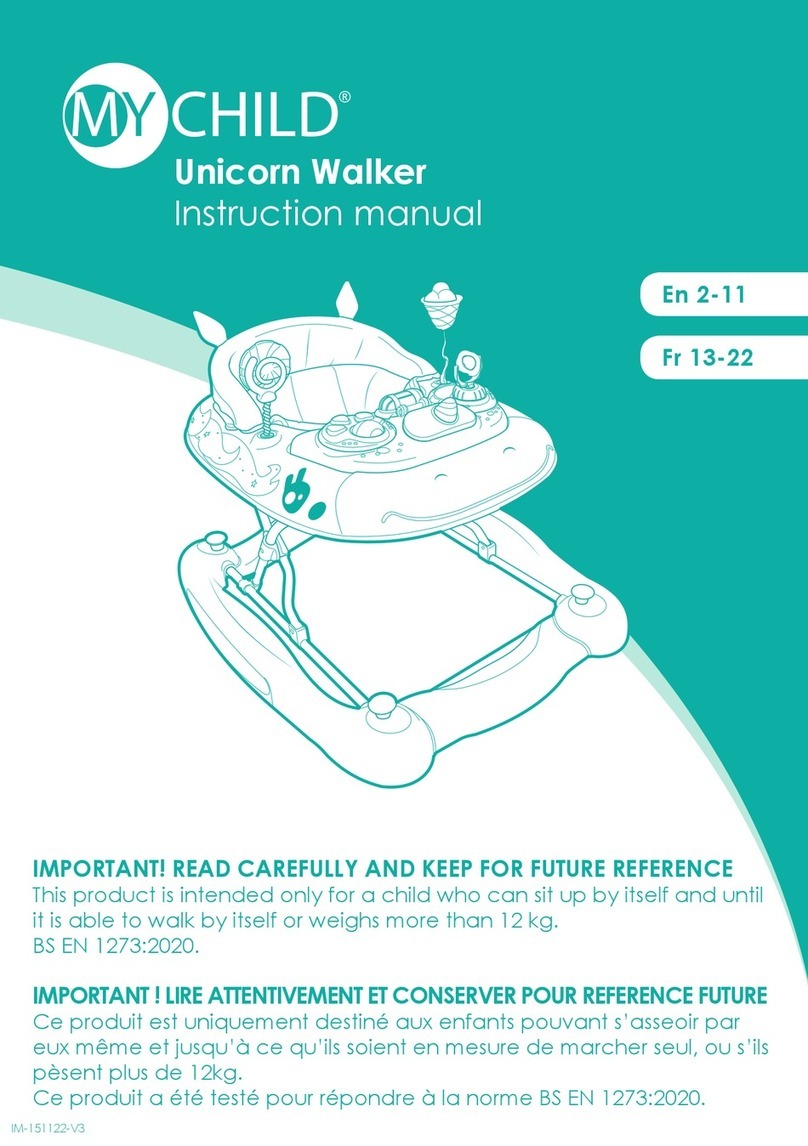
My Child
My Child IM-151122-V3 instruction manual

NRS Healthcare
NRS Healthcare Mowbray Lite M66613 User instructions

Rhythm Healthcare
Rhythm Healthcare B3150 quick start guide
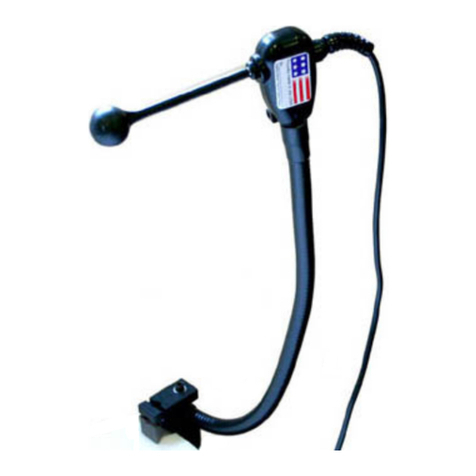
Enabling Devices
Enabling Devices Ultimate Switch user guide
